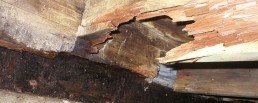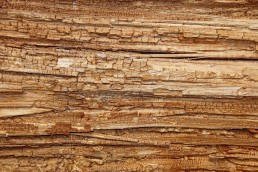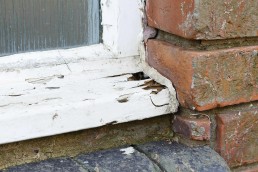How to Stop or Prevent Wood Rot
Wood rot is a serious concern that not only damages the timbers in a building, but can cause hazardous structural problems within a home or commercial property.
There are two types of wood rot: wet and dry rot. Both types affect timbers by causing the wood to decay, and both thrive in wet or damp conditions. It’s essential to know how to prevent and treat rot before it causes damage.
In this article, we explore the best ways to stop and prevent wood rot.
What are the Different Types of Wood Rot?
The two types of wood rot – wet and dry rot – are both caused by fungal spores that are attracted to damp timbers where they find their optimal conditions.
Wet rot is attracted to areas of extremely high moisture content, and the fungal spores can slowly eat their way through even the strongest of timbers. Wet rot is isolated and doesn’t spread easily, but it can cause extensive damage if left untreated.
Dry rot on the other hand can spread throughout a property, as it rapidly makes its way through timbers. Dry rot needs much less moisture to survive, so spreads easier than wet rot.
How to Stop Wood Rot?
Both types of wood rot result in mushroom-like smells, so even if you can’t see the rot you’ll be able to smell it. It’s crucial that you act quickly before rot can take hold or spread through a building.
Wet rot can be treated with effective fungicides, which destroy the fungal spores. However, if the rot has eaten into timbers, these will need to be removed and replaced to prevent structural hazards. Because wet rot thrives in moist conditions, it’s important that any source of moisture is removed and that the area is properly ventilated.
Dry rot can cause damage more quickly than wet rot, and all sources of moisture need to be removed to stop it from spreading. Fungicides can be used to treat and kill existing spores, as well as preventing others from spreading. However once the rot has taken hold, timbers often need to be removed and replaced to ensure the structural stability of a building.
How to Prevent Wood Rot?
While wood rot treatments are effective ways to remove existing types of rot that have already taken hold in a building, it’s always preferable to prevent rot from spreading in the first place.
Dry and wet rot treatments can be very disruptive, particularly if the rot has begun to spread through important timbers and supports in the home. Supporting timbers may need to be removed and replaced, or else they can become a structural health and safety hazard.
These invasive and intense treatments are much more expensive than prevention techniques. Homeowners can prevent rot from taking hold through adequate ventilation, preventing the build-up of moisture on wooden surfaces, and applying fungicidal wood rot treatments that prevent rot from spreading.
Get More Information on Wood Rot Treatments
For more information and advice on how to stop and prevent wood rot, please contact our friendly team on 01765 804050 or fill in our online contact form. Our experienced professionals will be on hand with expert advice tailored to resolve your problem.
How to Treat Wood Rot
Wood rot is caused by fungal spores eating their way through wooden timbers, be it wooden furniture, door frames, or even the structural supports holding a building together.
As timbers decay they become increasingly unstable and dangerous, leaving a major health and safety hazard inside your home or commercial property.
So how do you treat wood rot and prevent it from returning? In this article, we explore the best ways to treat wood rot.
What are the different types of wood rot?
There are two distinct types of wood rot that need to be considered before any treatments can be recommended and applied. These are wet rot and dry rot.
Both types of wood rot are caused by fungal spores eating through cellulose found in timbers. Both only occur in wet and damp conditions, as the fungal spores are activated by moisture.
Wet rot requires extremely high levels of moisture to survive, so it’s only found in incredibly damp conditions. Wet rot mostly remains static, but causes large amounts of damage when left untreated.
Dry rot requires much lower moisture levels to thrive, so it can easily spread through a home from one timber to the next. Dry rot can quickly cause damage as it spreads, and needs to be treated rapidly.
What are the signs of Wood Rot?
While wood rot might not be visible on the surface, it could be causing massive amounts of structural decay beneath the timbers.
For this reason, it’s important to be given a proper diagnosis by a professional who can locate and identify different types of wood rot that could be afflicting your home, before recommending the best course of treatment.
If you notice any of the following signs of wood rot, it’s time to call in a specialist.
● Musty or mushroom-like smells
● Growth of mould
● Soft timbers
● Discolouration of timbers
● Visible decay of timbers
● Areas of damp
How to identify and treat wood rot?
The exact treatment depends on the extent of the wood rot, how long it has been spreading for, and the damage that’s already been caused.
The first step is to identify where the rot has taken hold and the type of rot that’s present in the property. While dry rot can be very visible, wet rot is often hidden out of sight.
The most effective method of wood rot treatment is to apply a fungicide or chemical spray. This kills any existing spores and creates a protective anti-fungal layer that stops future fungal spores from establishing themselves on timbers. This only works however if the rot is on the surface.
If the wood rot is below the surface or has already caused extensive damage to important, structural timbers, then the only treatment is to remove the timbers and replace them. This is much costlier and more disruptive, which is why it’s so important to act fast when you suspect the presence of wood rot in your property.
Get in touch with Wood Rot Treatment Specialists
For more information and advice on how to treat wood rot – both wet and dry rot – then please contact our friendly team on 01765 804050 or fill in our online contact form. Our experienced professionals will be ready to offer expert advice tailored to resolve your problem.
A Simple Guide for Buying or Selling a House with Dry Rot
Buying or selling a house with dry rot can be a big challenge for both the buyer and seller. Dry rot can cause serious structural damage to a property and, in almost all cases, banks will refuse mortgages on homes where dry rot is present.
If you’re trying to sell a house with dry rot, it’s in your best interest to treat the dry rot before placing the property on the market. If you live in a place where dry rot is a common problem, it is highly advised that you have your home inspected professionally before putting it up for sale.
Equally, it’s important to inspect a property for dry rot and other problems, before you attempt to purchase it, otherwise you may find yourself left with expensive repair bills further down the line.
If you are thinking of buying or selling a house with dry rot, the team at Danford Brewer & Ives is here to explain everything you need to know.
What Is Dry Rot?
Dry rot is a type of fungi that spreads rapidly while showing very few signs of visible damage. But it can cause underlying structural problems if left untreated. Dry rot can be found in timbers, where fungi eat their way through the material, using wood as a source of nutrition. The fungal spores then move through the wood, leaving behind a trail of damage and destruction. Because timbers are often hidden away, dry rot can remain out of sight until serious damage becomes visible.
The fungal spores that cause dry rot are activated by damp conditions, however it’s important to note that dry rot is different from wet rot. In comparison to wet rot, dry rot is more dangerous, as it requires less moisture to thrive and spread.
What Are the Signs of Dry Rot?
As a buyer or seller, it’s important to keep your eyes open and be aware of the first signs of dry rot. If dry rot isn’t taken seriously, it won’t only cause expensive damage, it can decrease the value of a property or render it unsellable.
If you purchase a property only to find out later that it has dry rot, it would be on your shoulders to treat the issue if you don’t want to have to deal with further structural damage.
Because it’s so important to spot dry rot, especially before buying a property, we always recommend having a professional damp and timber survey carried out.
However, there are a few signs that might help you to detect dry rot:
- Pungent smell
- Puckered wood or bumpy wood
- Soft or spongy wood
- Wood cracks
- Paint cracks or chipping
- Wood discolouration
If you see any of these signs, the team at Danford Brewer & Ives can carry out a thorough, detailed survey of the property.
Should I Buy a House with Dry Rot?
If you discover that the house you’re hoping to buy has dry rot, it’s inadvisable to purchase it in its current state. In fact, if the property has dry rot, banks are unlikely to even approve a mortgage.
However, this doesn’t mean you can’t negotiate with the seller and bank. If dry rot is found, a bank could approve a mortgage on the condition that the current owner treats the dry rot before the sale is completed.
If you’re a cash buyer, the same principles apply. If dry rot is discovered, you can ask the current owner to fix the issues or negotiate a discount that would cover the cost of the work later.
Can I Sell a House with Dry Rot?
If you’re attempting to sell a house with dry rot, you’ll find it extremely difficult. Banks only approve mortgages on the condition that a survey is carried out before the purchase. This pre-purchase survey would identify any dry rot and other related issues of dampness, rot, or mould, thus making the house unsellable or seriously depreciating its market value.
If you want to sell your home, it’s a good idea to have it inspected for dry rot before placing it on the market. If problems are identified, having them fixed will help the property to keep its value and make the sale process much more efficient.
How Can Dry Rot Be Treated?
You might think that it isn’t essential to treat dry rot before selling a house. However, it can have a significant impact on its selling price. If a buyer detects dry rot, you will likely get a lower price for your house in comparison to the amount you pay for treatment.
But dry rot can be treated, although the treatment and costs depend on how far the dry rot has spread and how much damage has been caused.
If dry rot is mostly on the surface of the wood and has not penetrated deep into it or if it has not caused any structural damage to the property, then it’s likely that you will pay less for treatment.
Sometimes, dry rot treatment can be as simple as cleaning the dry rot using a specialist wood treatment or fungicide. This is followed by a fresh coat of wood paint to stop dry rot from returning in the future. In this instance, dry rot treatment costs remain low while you raise the value of your home at the same time.
If dry rot has been left untreated, then it may spread through the timbers. If timbers have been seriously decayed, they may need removing and replacing. This is when dry rot treatment becomes expensive, as a lot of work is needed to ensure the structural stability of the home.
Due to potential damage dry rot can cause, if you are purchasing a house where dry rot is a problem, it is advised that you take a professional with you to ensure there is no chance of missing any signs.
An expert will not only investigate dry rot, but they’ll also tell you the scale of damage. Detecting the extent of dry rot requires experience and expertise, so a professional’s help is a much better idea than trying to investigate dry rot by yourself.
If you have already bought a home and have consequently found signs of dry rot, hiring a professional to investigate should be your top priority. After investigation, have the dry rot treated as soon as possible to stop it from spreading and causing devastating damage to your new property.
Contact Danford Brewer & Ives to Find Out More About Buying or Selling a Home with Dry Rot
If a property has dry rot, it will lose value and become difficult to buy or sell. If you’re planning on putting your home on the market or if you’re interested in purchasing a property, it’s essential to have a professional inspection carried out.
Danford Brewer & Ives can check properties for dry rot, in addition to other issues such as wet rot or damp that may cause problems for buyers and sellers. Contact our experienced team today to find out more.
How to Inspect Your Windows and Doors for Wood Rot
Guide to Inspecting Your Windows and Doors for Wood Rot
Wood rot initially might not appear to be a big problem. It may often go completely obscure. Essentially, dry wood rot is a fungus that spreads and grows in the moist areas within the wood. Windows and doors are at high risk of wood rot. Therefore, you would have to keep an eye on every change in your windows and doors.
Dry rot is more dangerous than wet rot. The sooner you will detect dry rot in your windows and doors; more are the chances that you will be able to fix the problem without spending a ton of money. However, if you delay the wood rot inspection and detect it when it is too late, then you would be left with no other choice but to replace the wood. In the worst case, the dry wood rot can cause structural damage to your home.
To stay on the safe side, inspecting dry wood rot should be on your to-do list regularly; especially for the parts of the house that are exposed to water or receives the most rainfall. Older homes are at a higher risk of dry wood rot as compared to homes built within two years. If you detect dry wood rot, fixing it should be on top of your to-do list because you should never delay its treatment on your windows and doors.
There are a few signs that might help you detect wood rot:
Wood Feels Soft to Touch:
The wood should never feel soft! If your wood feels soft or spongy, you should immediately check for dry rot.
Discolouration:
If you see that colour of your window or door is changing, then it might be an indicator of dry rot. If your wood is painted, you might see signs like paint chipping or crackers before wood discolouration is apparent.
Wood Starts To Pucker Or Crack:
Cracks or splitting can occur due to several reasons; however, if your window or door has started to pucker or bump, then it is a clear sign of dry rot.
Dry Rot Smell:
If your windows and/or doors have dry rot, it might emit a musty, fungal and damp smell. The smell does not indicate the intensity/level of dry rot; however, it plays a crucial role in detecting dry rot at an early stage.
If you inspect any of these signs, you should contact a professional to investigate the damage and get help to resolve the problem. However, you can start the inspection yourself by poking the wood with a knife or a screwdriver. If the wood has dry rot, you will be able to poke a hole in wood easily. Damp rot signs are usually more visible; thus, it is possible to take care of it and fix it on time. Whereas, dry rot acts more like a silent killer for wood.




